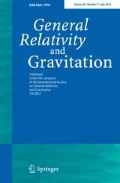Abstract
Inclusion of the four-derivative terms ∫R μν R μν(−g)1/2 and ∫R 2(−g)1/2 into the gravitational action gives a class of effectively multimass models of gravity. In addition to the usual massless excitations of the field, there are now, for general amounts of the two new terms, massive spin-two and massive scalar excitations, with a total of eight degrees of freedom. The massive spin-two part of the field has negative energy. Specific ratios of the two new terms give models with either the massive tensor or the massive scalar missing, with correspondingly fewer degrees of freedom. The static, linearized solutions of the field equations are combinations of Newtonian and Yukawa potentials. Owing to the Yukawa form of the corrections, observational evidence sets only very weak restrictions on the new masses. The acceptable static metric solutions in the full nonlinear theory are regular at the origin. The dynamical content of the linearized field is analyzed by reducing the fourth-order field equations to separated second-order equations, related by coupling to external sources in a fixed ratio. This analysis is carried out into the various helicity components using the transverse-traceless decomposition of the metric.
Similar content being viewed by others
References
Weyl, H., (1921).Raum-Zeit-Materie, 4th ed. (Springer-Verlag, Berlin) [English translalation (1952)Space-Time-Matter (Dover, New York], Chap. IV; Eddington, A. (1924).The Mathematical Theory of Relativity, 2nd ed. (Cambridge University Press, London), Chap. IV. Later suggestions were
Lanczos, (1938).Ann Math.,39, 842; Buchdahl, H. A. (1948).Proc. Edinburgh Math. Soc.,8, 89.
Pais, A., and Uhlenbeck, G. E. (1950).Phys. Rev.,79, 145.
Utiyama, R., and De Witt, B. (1962).J. Math. Phys.,3, 608; DeWitt, B. S. (1965).Dynamical Theory of Groups and Fields (Gordon and Breach, New York), Chap. 24; Sakharov, A. D. (1967).Dokl. Akad. Nauk SSSR,177, 70 [(1968).Sov. Phys. Dokl.,12, 1040.]
De Witt, B. S. (1975).Phys. Rep.,19C, 295.
't Hooft, G., and Veltman, M. (1974).Ann. Inst. Henri Poincaré 20, 69; Deser, S., and van Nieuwenhuizen, P. (1974).Phys. Rev. D,10, 401, 411; Deser, S., van Nieuwenhuizen, P., and Tsao, H. S. (1974).Phys. Rev. D 10, 3337.
Stelle, K. S. (1977)Phys. Rev. D. 16, 953.
Pechlaner, E., and Sexl, R. (1966).Commun. Math. Phys.,2, 165; 3rd paper in [6]; Havas, P., (1977). Temple University preprint.
Long, D. R. (1976).Nature,260, 417.
Mikkelsen, D. R., and Newman, M. J. California Institute of Technology preprint No. OAP-475.
Rivers, R. J. (1964).Nuovo Cimento 34, 387.
van Nieuwenhuizen, P. (1973).Nucl. Phys.,B60, 478.
Ostrogradski, M. (1850).“Mémoires sur les équations differentielles relatives au problème des isopérimètres,” Mem. Acad. St. Petersbourg,VI4, 385; see also Whittaker, E. T. (1937).Analytical Dynamics of Particles and Rigid Bodies, 4th ed. (Cambridge University Press, London); and also [3].
Deser, S. (1970).Gen. Rel. Grav.,1, 9.
Arnowitt, R., Deser, S., and Misner, C. W. (1962), inGravitation, an introduction to current research, ed. Witten, L. (Wiley, New York).
Matthews, P. T. (1949).Proc. Cambridge Phil. Soc.,45, 441.
Coleman, S. (1970). “Acausality” inSubnuclear Phenomena, ed. Zichichi, A. (Academic Press, New York).
Lee, T. D., and Wick, G. C. (1969).Nucl. Phys.,B9, 209; (1969).B10, 1.
Author information
Authors and Affiliations
Additional information
Research supported in part by the National Science Foundation under grant No. PHY-76-07299.
Rights and permissions
About this article
Cite this article
Stelle, K.S. Classical gravity with higher derivatives. Gen Relat Gravit 9, 353–371 (1978). https://doi.org/10.1007/BF00760427
Received:
Issue Date:
DOI: https://doi.org/10.1007/BF00760427



